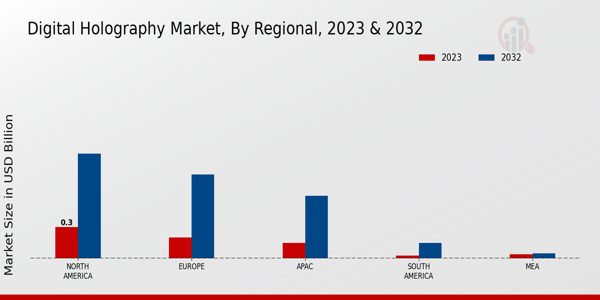Growing Demand in Research and Development
The Digital Holography Market is witnessing an increasing demand from research and development sectors. Academic institutions and research organizations are adopting digital holography for various applications, including fluid dynamics and nanotechnology. The ability to capture three-dimensional images with high precision is facilitating groundbreaking research. According to recent estimates, the investment in R&D related to digital holography is expected to reach several million dollars annually, reflecting a robust interest in this technology. This trend is likely to bolster the Digital Holography Market, as more researchers seek to leverage holographic techniques for innovative solutions.
Increased Investment in Defense and Aerospace
The Digital Holography Market is experiencing heightened investment in defense and aerospace sectors. Holographic imaging is being utilized for various applications, including target recognition and navigation systems. The defense sector's focus on advanced technologies is driving demand for digital holography, with investments projected to increase significantly in the coming years. Reports indicate that the defense budget allocations for advanced imaging technologies could rise by over 20%, reflecting the strategic importance of these capabilities. As defense and aerospace industries continue to evolve, the Digital Holography Market is likely to see substantial growth opportunities.
Technological Advancements in Imaging Systems
The Digital Holography Market is experiencing a surge in technological advancements, particularly in imaging systems. Innovations in laser technology and sensor design are enhancing the quality and resolution of holographic images. For instance, the integration of high-speed cameras and advanced algorithms is enabling real-time holographic imaging, which is crucial for applications in fields such as medical diagnostics and materials science. The market is projected to grow at a compound annual growth rate (CAGR) of approximately 25% over the next five years, driven by these advancements. As imaging systems become more sophisticated, they are likely to attract a broader range of industries, thereby expanding the Digital Holography Market significantly.
Integration with Augmented and Virtual Reality
The Digital Holography Market is poised for growth through its integration with augmented reality (AR) and virtual reality (VR) technologies. Holography enhances the immersive experience of AR and VR by providing realistic three-dimensional visuals. This integration is particularly relevant in sectors such as gaming, education, and training simulations. The market for AR and VR is projected to reach billions of dollars, and the incorporation of holographic technology is expected to drive further expansion. As industries increasingly adopt AR and VR solutions, the Digital Holography Market is likely to benefit from this trend, leading to innovative applications and increased market share.
Rising Applications in Security and Surveillance
The Digital Holography Market is expanding into security and surveillance applications, where the need for advanced imaging techniques is paramount. Holographic imaging offers enhanced capabilities for identifying and tracking objects, making it a valuable tool in security systems. The market for security-related holographic applications is anticipated to grow significantly, with estimates suggesting a potential increase of over 30% in the next few years. This growth is driven by the increasing need for sophisticated surveillance systems in both public and private sectors. As security concerns escalate, the Digital Holography Market is likely to play a pivotal role in developing next-generation security solutions.

















Leave a Comment